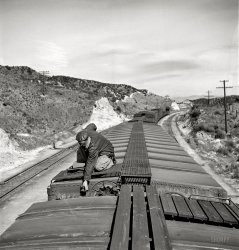
MAY CONTAIN NUTS

Search Shorpy
SHORPY ART

Framed or unframed, desk size to sofa size, printed by us in Arizona and Alabama since 2007. Explore now.
Join and Share
Ad-Free Shorpy
Shorpy is funded by you. Patreon contributors get an ad-free experience.
Learn more.

Recent comments
- Party of Eight?
- Good choice
- Recent view
- Hudson’s Big Store
- Say what??
- Grapes?!
- Just a Great photograph.
- A Beautiful Moment
- Such joy
- Bethune-Cookman University today
- Yellow sky at morning
- Side Winder
- Air Quality?
- Sojourner Truth riot
- None were so blind(ed)
- The less famous sister
- Good ol' days?
- Rise and Fall
- Goo Goo Ga Joob
- Ticket Retention
- Not the only one
- Vagaries of War
- Killed by Amtrak
- Back to the Future
- Wanted --
- If you can't stand the light
- Centralized Traffic Control, I believe
- What's really happening
- Heckuva remote control!
- Sometimes — Things Go Bump!
Member Photos
The Shorpy
Print Emporium
Print Emporium
Search Shorpy
Search results -- 30 results per page
- Steeling Home: 1941
- ... Pennsylvania." Medium format acetate negative by Jack Delano for the Farm Security Administration. View full size.
The rest ... Posted by Dave - 04/04/2022 - 5:30pm -
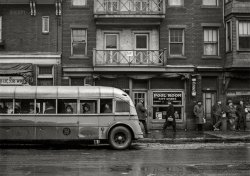
- Locomotive Lair: 1942
- ... Western Railroad. Chicago, Illinois." Nitrate negative by Jack Delano, Office of War Information. View full size.
Proviso Yard Noir ... Posted by Dave - 08/12/2022 - 11:01am -
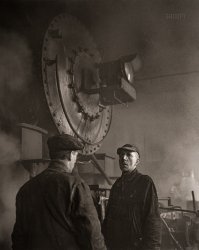
- Corwith Yard, Chicago: 1943
- ... 1943. View full size. 4x5 Kodachrome transparency by Jack Delano, who went with the train to California, taking pictures along the way ... Posted by Dave - 07/30/2012 - 10:02pm -
![Corwith Yard, Chicago: 1943 Santa Fe freight about to leave for the West Coast from the Corwith yard in Chicago. March 1943. View full size. 4x5 Kodachrome transparency by Jack Delano, who went with the train to California, taking pictures along the way with his Graflex Speed Graphic. Look for them here in the coming days.
Color PhotographyDelano's color shots are amazing for that era, when color tended to be a little fuzzy and indistinct.
[After the introduction of Kodachrome film in the 1930s, color photography was probably as sharp or sharper than it is today, given the large-format cameras they had. It was print reproduction, whether in snapshots or magazines, that tended to suffer - Dave]
RR trip out westWhat a lucky guy Delano was to be able to travel from Chicago to LA on the ATSF, I would love to do that myself today with BNSF. I'll be looking forward to seeing his trip pictures on Shorpy soon. By the way this site is absolutely great, love seeing all the historical pictures of how things were 100 yrs ago. I know we couldn't live like that today with how much technology has changed us & the world.
Re: RR trip out westLook for more of those next week. In the meantime I've posted a Delano shot of a freshly painted caboose.
"I know we couldn't live"I know we couldn't live like that today with how much technology has changed us & the world."
But........ don't you wish we could!?
Stuff Greenies and Global Warming......bring back steam!
(The Gallery, Kodachromes, Chicago, Jack Delano, Railroads)](https://www.shorpy.com/files/images/1a34702u.thumbnail.jpg)
- Sgt. Choken: 1943
- ... two years in the Civilian Conservation Corps." Photo by Jack Delano for the Office of War Information. View full size.
Reminds me ... Posted by Dave - 07/27/2012 - 1:50pm -
![Sgt. Choken: 1943 July 1943. "Myrtle Beach, S.C. Air Service Command. Mobile chief Technical Sergeant Vasile Choken, whose home is in Akron, Ohio. In civilian life he drove a truck, ran a filling station and spent two years in the Civilian Conservation Corps." Photo by Jack Delano for the Office of War Information. View full size.
Reminds meof those cigarette ads that featured sports figures who espoused the merits of a good smoke to enhance performance.
Johnny U, I miss you.
Smoke 'em if ya got 'em.
Chokem if you got 'em!Sorry, I just had to.
He's smoking an unfiltered. Notice that the brand name is toward the lit end.
Times have changedDuring WWII, cigarettes were 5 cents a pack for the military through the PX, and I am told that in combat zones they were free. I recently read in Stars & Stripes that the Department of Defense has instituted a program to eradicate smoking in the military in the next 20 years.
A cig and a squintAside from the sporty all American ballcap, this fellow gives off a nice Clint Eastwood vibe. I nominate him for the Handsome Rakes gallery. He must be bachin' it, as any woman he kept handy would probably shave the little Brillo pad growing at the nape of his neck.
Ciggie terminologyBack in my hometown regular folks, farmers and shop workers were said to smoke "rolled" cigarettes, which they made themselves, while executives and the well off could afford "tailored" cigarettes bought at the corner store.
At Christmas, tailored cigarettes, packaged in lovely tin humidors, were considered a classy gift for Dad or that special guy.
Chokem vs. ChokenLooks like Jack Delano got the surname slightly wrong. There is no Chokem in the Social Security Death Index. But:
Vasile CHOKEN
Birth Date: 14 Jan 1918
Death Date: 20 Aug 2004
Social Security Number: 285-12-3952
State or Territory Where Number Was Issued: Ohio
Death Residence Localities
ZIP Code: 44313
Localities: Akron, Summit, Ohio
Fairlawn, Summit, Ohio
Shag tobaccoIn the Netherlands (where I am from) rolling your own "sjekkies" is still a very common practice. One can purchase a wallet size pouch with fine-cut tobacco pretty much in any supermarket, drugstore or kiosk, along with "vloei" -- very thin rolling paper.
My Grandfather used to have a little rolling machine which he primarily used to roll his sigarettes after he suffered a stroke rendering the left side his body pretty much limp.
Hazards of smokingMr. Choken smoked unfiltered cigarettes and lived to 86. Maybe he quit at a young age.
Handsome!Thanks Shorpy, for providing me with pictures of all these good looking men.
July 1943My birthday!!!
Oh myHubba hubba!
Service ManShag that? Sure I would. He's a handsome guy. You can see what might have made American troops welcome lots of places if they were all as cute as this guy. (He's the age of my father who was also in the Army during WWII. He'd be appalled at these sentiments of mine!)
A 65 year difference65 years ago, 25 year old guys probably had worked 2 or more jobs to make ends meet and either joined up or were drafted into the war effort. Today the majority of 25 year olds are trying to pay off huge college debt, trying to find a job, and probably living in their parents' basement. I think I'd rather be smoking an unfiltered Camel.
Wheels DownSgt. Choken is hereby cleared for approach. Night landings especially. Hubba hubba!
Jeez LouiseHoly cow, that boy is hot*.
Please, let's have more of the same.
* Yeah, yeah. I know. Does it really matter? The boy is smokin'.
Handsome Rake!!Dave, you have to add this guy to the list. Your attention to the Rake department lags disgracefully behind your identification of Pretty Girls. Do I have to boycott or something? Don't make us girls go hunting all over 5 zillion images for our cheesecake when the men have it all helpfully labeled for them.
Hubba hubba. Rowr.
[Alright. He now ranks among the rakes. - Dave]
Eat your heart out, Bruce Weber!Vasile. What a beautiful Romanian name.
DadThat's my dad.
[What can you tell us about him? - Dave]
Vasile Choken, my fatherFirst and foremost he was a good man. He had the most amicable and easygoing disposition of anyone I have ever met.
The original spelling of the name was Ciokan but at roll call they could never pronounce it so he changed it to the phonetic spelling of Choken.
He was also a good soldier, he was later sent to Officer's School where he received his commission and became a flight engineer on B-25's and B-17's.
He was married to the love of his life, Helen, for 57 years. He had four children (two boys, two girls). I'm his younger son.
When he left the service he returned to Akron, where he spent most of his adult life. He retired from the Akron Board of Education after 35 years.
All in all a good life well spent.
Ciokan=ciocan=hammerI am Romanian and I can tell you that his name was previously Ciocan, which in Romanian language means "hammer" -- a very suitable name for this nice guy.
(The Gallery, Handsome Rakes, Jack Delano, WW2)](https://www.shorpy.com/files/images/8d32096u.thumbnail.jpg)
- Cajon Pass: 1943
- ... View full size. 4x5 Kodachrome transparency by Jack Delano for the Office of War Information.
Mormon Rocks Those are the ... Posted by Dave - 08/03/2012 - 11:33am -
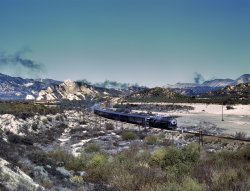
- Career Girl: 1943
- ... Co." Our third look at Frances on the job. Photo by Jack Delano for the Office of War Information. View full size.
D.C. Tag ... Posted by Dave - 03/08/2014 - 1:10pm -
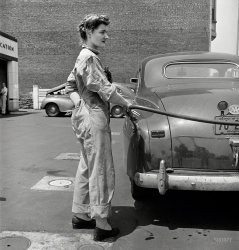
- I Am the Egg Girl: 1940
- ... Du Bois. View full size. 3¼ inch safety negative by Jack Delano, Farm Security Administration.
Watch? Another great Delano image ... Posted by Dave - 08/16/2012 - 8:00pm -
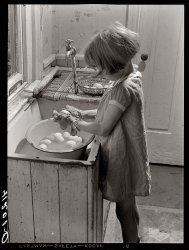
- Bill London: 1942
- ... at the Proviso yards." 4x5 Kodachrome transparency by Jack Delano for the Office of War Information. View full size.
What Do You ... Posted by Dave - 08/30/2012 - 4:46pm -
![Bill London: 1942 December 1942. Melrose Park, Illinois. "Chicago & North Western RR. William London has been a railroad worker 25 years -- now working at the roundhouse at the Proviso yards." 4x5 Kodachrome transparency by Jack Delano for the Office of War Information. View full size.
What Do You Say, Girls?Something tells me this guy won't qualify for the "Handsome Rake" category.
Respirator?I got yer respirator right here, pal...
I wouldn't vouch for...his pulmonary quality of life.
Good StandingLooking at what he is wearing, and how much grime he has, I would guess he is a "Member of Good Standing" of the Boilermakers Union.
ObviouslySmoking will be the least of his worries.
Pall MallOutstanding, and they are MILD!
Now wait a secondWorking on steam locomotives was a dirty grimy business, and smoking in that age was not only acceptable but often encouraged. To criticize his dirty demeanour and appearance is reprehensible. He was one of the hard working railroad men who helped the U S win the war and should be remembered as such, not criticism based on modern standards. Mr London, I salute you.
The colours!Yes, of course it's ridiculous, but some part of my brain thinks that the past was actually in black and white.
Working etc.All the flippin' livelong day.
Re: What Do You Say, Girls? I think his eyes are beautiful. Perhaps with a good shave, a thorough bath, and a dandy set of clothes, this gent could be a handsome rake. Also, not to stir up too much controversy, but why do you think that 'Girls' are the exclusive judges of whether a man befits the tag of "Handsome Rake"? Are men the sole judges of a woman's beauty?
The People, YesThis guy's mug is what Carl Sandburg meant in 1936. Without guys like this, who knows where the country would be?
Fark R.R.Farked again.
Ashes by NowLooks like he has spent a lot of time inside boilers, including the shift he is on.
Starting to see some gray under the hat. Much as people like steam engines the amount of grueling hard labor it took to keep them running compared to the diesels was one of the major reasons they disappeared so quickly once WW2 was over and industrial resources were realigned.
RR grimeFrom the goggles and collar buttoned up to his neck, to keep cinders and such out of your eyes and off your body as the engine goes down the track, he could've been in engine service. Or, from as dirty as he is, could be a roundhouse employee, maybe uses a cutting torch or somesuch tools and would need eye protection. More than likely a round house or shops employee. Either way, he is leaning on the drawbar on the front of a locomotive.
[As noted in the photo caption, he is a roundhouse employee. - Dave]
You didn't wear your work clothes home. At the end of the shift you went to the changehouse and changed out of that garb and put on you regular clothes.
Mama would beat you for coming into the house in those clothes. Not sure when they got washed. I've talked to folks here in town whose menfolk worked in the shops here and talked about just that topic, but I can't remember what they said.
Like to know what that button on the bill of his cap says.
(The Gallery, Kodachromes, Chicago, Farked, Jack Delano, Railroads)](https://www.shorpy.com/files/images/1a34672u.thumbnail.jpg)
- Trucks Akimbo: 1939
- ... "Fields of Vision" series--along with Esther Bubley and Jack Delano!
Not a model Took me a while, but before I looked at the other ... Posted by Dave - 09/13/2011 - 8:18pm -
![Trucks Akimbo: 1939 September 1939. "Minneapolis, Minnesota. Trucks loading at farm implement warehouse." 35mm nitrate negative by John Vachon. View full size.
Looks like scale models in a set.Particularly everything from the train tracks up. The lower section doesn't have the sheen or something to carry it off.
The two guys in and around the truck don't help either.
I wondered at firstLooking at the top half of the picture I almost thought it was one of those amazingly detailed models we see occasionally, but then I saw the guy hanging out of the truck window bottom left!
ToysThis looks like a bunch of toys. If only it was also a tilt/shift photograph.
Traffic JamLooks like a game of Traffic Jam with 30's vehicles.
ModelesqueI know the photo is real, but it looks like one of Michael Paul Smith's images.
Tonka! This so looks like a kid's play area with all his little cars and trucks. Hope he isn't in the mood for an accident.
Slightly SurrealThere is a definite air of artificiality here, in spite of the fact that this
is an authentic photograph of a real-life scene. Is it the rakish angle?
The floating-above-it-all perspective? It screams "scale model" as in
a contrived cityscape in a model-enthusiast's basement.
1934Never mind the big Minneapolis truckers strike in 1934, in which the National Guard was called in to shoot the strikers in the streets. It's a big deal in Labor history, particularly in Minnesota. But have fun with it.
Doublemint twinsI had no idea their ad concept went back that many years.
The year before I was born!Amazing that this was possible with 35mm, but if you examine the photo carefully you wil see that only the truck in the upper center is in really sharp focus.
Great Northern Freight YardI believe this is one of the freight houses behind the GN depot in Minneapolis. The yard was bisected at 4th Avenue North, where I think the 1939 photo was taken. There is one remaining building that is today used for housing.
Don't pass on the rightI found it interesting that the truck crossing the tracks only had a mirror on the right side. I though that may have been a traffic hazard till I noticed that none of the many vehicles had side mirrors at all!
WOW, Clean!!!!I am amazed at how clean this area and the trucks appear. Very little litter laying around and absolutely ZERO graffitti. Of course the spray paint can wasn't invented yet.
Batman!This totally looks like a panel from a Batman comic.
AkimbophileGood to be able to use a word like "akimbo" any time. A wonderful word that is perfect. It just rolls off the tongue so nicely. And works well in Scrabble at times.
City lifeCity life in the forties. Cars and trucks had awesome designs.
MatchboxesLooks like somebody's Matchbox collection in an HO scale layout.
A guessSomehow I think the guy hanging out of the window in the truck in the center of this started off his conversation with "Hey Lou!"
DizzyThe angle of the shot actually makes me dizzy.
Or the Untouchables!Which truck has the booze, and will Ness find it in time? They'll be headed back to the border for more if he doesn't!
Something's FishyOkay, I'll stick my neck out. I think these are scale models; cars, trucks and building. The vehicles are all too clean and perfect. No loading docks in sight, nor one human. That was my first impression yesterday and it's still my impression today.
[There are at least five people in the photo. - Dave]
Science is Helpless Also looks like a miniature set from a "Beast From 20,000 Fathoms" type movie. I'm waiting for a lizard to stomp on some of these cars and trucks.
Dioramais what this almost looks like except the people and the papers in the gutter say otherwise.
SurrealThis picture has an otherworldly quality, particularly when one views the full size version. The angles are unsettling and chaotic, and the vehicles begin to look like tiny toy model versions of their real selves. It's like a noir version of the intro to "Mister Rogers' Neighborhood." One almost expects to see John Garfield step out of that doorway.
"Wheeler"Now there's a perfect name for a transportation company.
Fourth AvenueThe "Freight Station" belonged to the Chicago & North Western Railroad on Fourth Avenue North near First Street. The building still survives, although has no railroad track anymore. Angle of the photo suggests it was shot from the roof of long-gone Security Warehouse.
1. A 1982 view.
2. Bird's eye view.
I see I'm not the only one that sees this as a model. So I looked at the image again and came up with some reasons why I think it looks like a miniature.
The angle of the camera doesn't seem to have any effect on the miniature. I rotated it, and still looks small.
I think the main reason is the lack of any harsh shadows and bright highlights. It could be early morning, or a cloudy day. A couple of trucks in the foreground do have sun on them, and the illusion seems to fail there. The way the cars are parked may have something to do with it. They are not perfectly parked by today's standards, and the guy on the sidewalk is asking for a ticket. The softness of the details in the above half also lend to the fact that the cars look die cast, and lacking in detail of a full size auto. Lastly, the angle of the shot is from somewhat of a humans eye view if they were looking down onto a table top. That's about it.
Supreme exampleAfter New York's police commissioner banned trucks with advertising sideboards (like the Doublemint ad on the Railway Express truck in lower right), Railway Express Agency tried but failed to convince the U.S. Supreme Court to overturn the regulation. In the 1948 decision, Justice Douglas added that "the fact that New York City sees fit to eliminate from traffic this kind of distraction, but does not touch what may be even greater ones in a different category, such as the vivid displays on Times Square, is immaterial."
C&NW Freight StationThe "Freight Station" is the building seen on the right in this Street View. Below that is another shot by John Vachon of the same scene.
View Larger Map
Memo to the "model" crowdTo avoid further embarrassment you might want to check out the other pics in this series.
John VachonShorpy-ites will be gratified to know that a book of John Vachon's photos was just added to the Library of Congress's excellent "Fields of Vision" series--along with Esther Bubley and Jack Delano!
Not a modelTook me a while, but before I looked at the other pictures I decided that while the angle certainly helps mess things up, what really got me was that the sizes of the trucks in comparison to that of the cars are smaller than they are today. I'm used to seeing trucks that are wider, or longer, or both. The "Wheeler Transportation" truck is what starts the whole "it's a model!" thing off for me. It looks like it doesn't belong, and, therefore, nothing else does, either.
At least until you look at the detail of the street cobbles, the weathering on the wheels, and etc., that is.
The Jack Greaves truck is the weirdest, with a bed that looks like a model bed, a person in the window that could go either way, but wheels that look like they are carrying a truck's worth of weight, which is something you never see in models.
Weird.
Shifty lookThe out-of-focus, tilt-shifty look in many of the pictures taken with these early 35mm Leicas was due to the film not being in entirely the focal plane. You had to be very careful loading. A redesign of the camera back around 1940 took care of the problem.
Real PeopleI am not certain how you all believe that this can be a model with those people in the picture. Sure, it looks a bit like toys but the people are hard to fake.
DoublemintLove the early Otis Shepard Doublemint gum billboard.
Otis Shepard's Doublemint twinsI love the Otis Shepard illustration on the side of the truck, too. I don't have an image of that particular one, but I do have color images of two others from the same campaign:
RE: Fourth AvenueThe building labeled "Freight Station" still exists and is residential. The building just out of the frame on the left side is the original Lindsay building, also now residential.
It's lowest level can be seen in the photo added by "Anonymous Tipster" on 5/20/2010.
RE: johnhill_3009 on Tue, 05/18/2010
The Security Warehouse building is still very much standing today (and yes, residential). Unless there was another building named Security Warehouse, it's much too far away (about 250 yards) to provide that perspective.
(The Gallery, Cars, Trucks, Buses, John Vachon, Minneapolis-St. Paul)](https://www.shorpy.com/files/images/8a04680u.thumbnail.jpg)
- The Ladies Who Lunch: 1943
- ... Mrs. Elibia Siematter at right. Kodachrome transparency by Jack Delano for the Office of War Information. View full size.
Painted ... Posted by Dave - 06/08/2017 - 8:42pm -
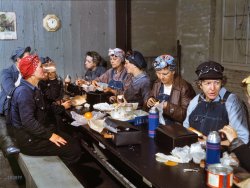
- Meet the Labbes: 1940
- ... in Wallagrass, Maine." Medium format acetate negative by Jack Delano for the Farm Security Administration. View full size.
Handrails ... Posted by Dave - 10/02/2021 - 11:10am -
![Meet the Labbes: 1940 October 1940. "Mr. and Mrs. Lindore Labbe and children in their newly-built home. Mr. Labbe, FSA client, runs a small seed foundation unit in Wallagrass, Maine." Medium format acetate negative by Jack Delano for the Farm Security Administration. View full size.
Handrails are for wimpsIf you fall, you might get lucky and land in the comfy chair.
More to the storyAccording to geni.com, the name was spelled LABBÉ, with an accent aigu. Mrs. Labbê's name was Myrtle, and the daughters were Gail and Jacqueline. Lindore was born in 1902, and lived until 1987. Myrtle was born in 1901, and died in 1972. That house may have been new, but it looks almost absurdly underbuilt to withstand - let alone provide comfort - in Maine winters.
[Their grave marker, sans accent, gives 1901 as the birth year for both. - Dave]
Settled in for the evening, they are.Let's see what's on the coal stove tonight. Oh, a finial -- not again.
NASCAR tie inIn NASCAR there is a full time Canadian driver in the Xfinity series named Alex Labbé. There also is a Mainer from Saco who is a former crew chief and now consultant named Slugger Labbe.
La-bay and Lab-bee.
LL Bean Maine Hunting ShoesMr. Labbe has on a pair of what is now known as Bean Boots but at least into the 1990s these were Maine Hunting shoes. I have a pair from 1990. LL Bean offers a resoling as needed.
Say Cheese!The youngster in the white shirt seems particularly enthralled with the photographers assistant (with hand visible) standing behind the brick chimney firing the flash.
Accent aigu (and grave)There's a longstanding debate over whether capital letters in French should be accented. The Académie Française has apparently decided yes, but it seems that the worker who carved the gravestone didn't get the memo. By the way, "Labbé" could well have been "L'abbé" originally, meaning "the abbot", but apostrophes in French surnames often get lost along the way.
BOO !!!Apparently, a Halloween monster is preparing to scare those youngsters as he climbs out of the wall!
Way Ahead of His TimeNot only did Mr. Labbe anticipate television replacing the stove as center of attention, he anticipated the remote control.
Thoughts on the roomI'm surprised no one has mentioned those STAIRS yet!
Cobbled together from left-over bits of T&G flooring (otherwise visible where the lino stops), with no riser covers and treads too shallow for the steps. At least the visible stringer appears to be well laid out and cut.
And what about the vast amount of paper covering the walls and ceiling? Photo shoot setup, to provide better reflected lighting and to hide unfinished walls?
[It's how people of limited means covered their framing. Lots of photos in the archive like this. - Dave]
AccentsIn France, adding an accent on a capital letter is uncommon. In Québec, we do. So, in France: LABBE. In Québec: LABBÉ (or LABBÉE).
I'm amazedat the amount of French-Canadians who infiltrated Maine, another fact from Shorpy to us in Canadaland.
Construction paperLooks like some of that paper is load-bearing.
(The Gallery, Agriculture, Jack Delano, Kids)](https://www.shorpy.com/files/images/SHORPY-8c03631a.thumbnail.jpg)
- Moving to Mexico: 1941
- ... a farm near Mexico, New York." Medium format negative by Jack Delano for the Farm Security Administration. View full size.
On the ... Posted by Dave - 02/14/2019 - 6:10pm -
![Moving to Mexico: 1941 August 1941. "Mrs. Myrtle Higgins of Leraysville, New York, with some of the belongings she has packed preparing to move out of the area being taken over by the Army. Mrs. Higgins has been selling eggs and berries in the town, and her son added to her $2 a week income by working in a junkyard in Watertown. She is moving to a farm near Mexico, New York." Medium format negative by Jack Delano for the Farm Security Administration. View full size.
On the GridsShe's leaving behind a riot of colors and patterns, from the linoleum floor to the oilcloth on the table to the wallpaper to the curtains. I wonder if she decorated her new home the same way, or opted for something calmer.
Pin MoneyAlong with the spices and hatpins Mrs. Higgins also appeared to have been something of a tacks collector.
Off the GridThe carbon mantle style kerosene lamps, likely Aladdin here, gave off a remarkable amount of light. Heat too. The one in my aunt and uncle's Wisconsin fishing cabin could also fry some of the mosquitoes that found their way inside through the window screens. The lamp would be surrounded by little vampire corpses after two or three rounds of cribbage.
Bright EyesIs that the sun shining in, or have they turned a searchlight on this poor lady?
[Photographer Delano believed in good lighting! - Dave]
Okade CoffeeI love vintage coffee cans.
My SonIs a gift from God, says the poster to the left
From findagraveAt Pulaski, Feb. 23. 1967, Mrs. Myrtle S. Higgins, Mannsville, widow of Edwin S. Higgins, aged 88 years. Funeral Saturday, 11 a.m.. Cleveland funeral home, Sandy Creek, Rev. Miles L. Hutchinson, pastor of the Mannsville and Lorraine Methodist churches, officiating. Spring burial in Maplewood cemetery, Mannsville.
https://www.findagrave.com/memorial/19145948/myrtle-higgins
Broken promiseAt upper left in the window, a broken window pane, that probably had been given "a lick and a promise" for quite a while, will now never be repaired. Why would she now when the Army will be tearing the house down?
Although she's started, she has a great deal of packing left. From the looks of the top box, she's an expert at doing so. She can take a minute to rest and pose for the photographer.
The "starts" of geraniums and African violets on her window sill garden, will be the last to go.
And speaking of lightI note an Aladdin Model 11 lamp with an inCREDibly dirty chimney in the centre of the table.
And … isn’t that a Westclox Big Ben mantel alarm clock?
She looks so young!Take away her granny glasses, granny dress, granny shoes; put on sneakers, a tshirt and ball cap and she looks like someone who could run a yoga studio.
Re: so youngShe really isn’t so old at all. Born in December 1879, she’s my age: 61. (But my yoga teacher, who’s at least a decade older, actually looks younger.)
Fort DrumIt appears that Mrs. Higgins was displaced by a pre-World War Two expansion of the Pine Camp military reservation. It subsequently became Fort Drum, and is still in existence and the home of the 10th Mountain Division.
https://en.wikipedia.org/wiki/Fort_Drum
So frilly they made me SQUEE!I love those dotted-swiss curtains!
(The Gallery, Jack Delano, Kitchens etc.)](https://www.shorpy.com/files/images/SHORPY-8c35411a.thumbnail.jpg)
- The City That Works: 1943
- ... View full size. 4x5 Kodachrome transparency by Jack Delano for the Office of War Information.
Chicago I worked in the ... Posted by Dave - 07/30/2012 - 10:05pm -
![The City That Works: 1943 Chicago, April 1943. "General view of part of the South Water Street Illinois Central Railroad freight terminal." View full size. 4x5 Kodachrome transparency by Jack Delano for the Office of War Information.
ChicagoI worked in the Wrigley Building the last 8 years, I love seeing pics of what the area was like. Hard to picture the rail where skyscrapers are now, and with the Trump Tower behind.
State of the BuildingsThey are so dirty! Obviously the smog at times was unbelievable from the trains.
[Soot. - Dave]
South Water Yard and freight houseAt least some of those tracks were there into the 1970s and early 1980s. I remember seeing strings of Illinois Central Gulf boxcars parked there, visible from the Outer Drive.
My father was in that freight house around 1950, when he was with New York Central. He recalled the flooring was of hardwood blocks with the end grain facing up.
He also recalled being there with a survey crew on another occasion when it was cold out, and his crew had to go to a nearby switch shanty to warm up. There was some guy in there, probably fresh from the old country, who smelled like he ate nothing but raw onions and garlic. He and his coworkers lingered there just long enough to get warm and RAN out of there!
ProtectionI like the particularly bright blue flags in place to protect carmen.
(The Gallery, Kodachromes, Chicago, Jack Delano, Railroads)](https://www.shorpy.com/files/images/1a34785u.thumbnail.jpg)
- The Cheshire Cows: 1940
- ... Cheshire, Connecticut." Medium format acetate negative by Jack Delano for the Farm Security Administration. View full size.
Undivided ... Posted by Dave - 04/27/2019 - 3:54pm -
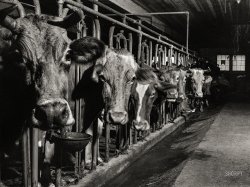
- The Orange Line: 1943
- ... plant in Redlands, California." Kodachrome transparency by Jack Delano for the Office of War Information. View full size.
... say banana?
(The Gallery, Kodachromes, Agriculture, Jack Delano) ... Posted by Dave - 06/27/2022 - 12:55pm -
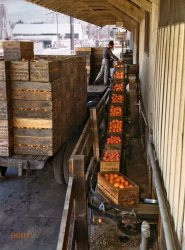
- Red Means Go: 1943
- ... freight terminal, Chicago." 4x5 Kodachrome transparency by Jack Delano. View full size.
Buildings ID'd The Tribune Tower, ... Posted by Dave - 05/21/2017 - 9:58pm -
![Red Means Go: 1943 April 1943. "Trucks unloading at the inbound freight house of the Illinois Central Railroad, South Water Street freight terminal, Chicago." 4x5 Kodachrome transparency by Jack Delano. View full size.
Buildings ID'dThe Tribune Tower, Wrigley Building and Masonic temple (now the Intercontinental Hotal). I think the photo is taken from the location of the current Illinois Center.
Wrigley Building on the leftWrigley Building on the left and Tribune on the right. Intercontinental Hotel (which used to be Masonic Temple) behind the Trib.
LocationYou've got the location down. That's because the Illinois Center used to be the terminus of the Illinois Central. For years, it was a big empty lot (and it is still only now being developed) and it was referred to as the "Illinois Central Air Rights".
air rightsThis section of (once) empty land is owned by IL Central RR. At the beginning of the skyscraper boom, the land became extremely valuable. The RR held on to the land ownership but sold the rights above the land (air rights) to developers that would later build the now familiar skyline. The skycrapers now in this area are privately owned, but the land on which they sit is still owned by the RR.
more?What is the far center and the brick on the right?
I.C. is no moreActually the I.C. was bought by the Canadian National a few years back, so the land is owned by them I guess :)
FakeObvious Photoshop. No color film in old days.
Re: Obvious PhotoshopI'd be interested to know what kind of "journalist" thinks color film didn't exist in the 1940s. Hope you're not a photographer - you'd need to quit and go back to school. (This is, by the way, one of our most frequent uninformed comments.) - Dave
Color photography?I'm sure this has been posted before, but to anyone who doesn't think color photography existed before 1960:
http://www.loc.gov/exhibits/empire/
Or how about WWI battle photographs:
http://www.worldwaronecolorphotos.com/
(warning, last I checked there were a few graphic pictures in the WWI shots)
I'm amazed people think we had color movies in the 1930's (Gone with the Wind, Wizard of Oz) but no color photography in the 1940's.
["Journalist" was disputing the existence of color film, not color photography. - Dave]
...and I quote:Although color photography was around prior to 1903, the Lumière brothers, Auguste and Louis, patented the process in 1903 and developed the first color film in 1907.
Building XDoes anyone know the name of the smaller gray building between the Wrigley and Tribune?
Re: Building XAnswering my own question, it's the Music Corporation of America Building. At first I could not locate a picture. After deducing the location to be 430 North Michigan Avenue I ran across a description of it at Emporis.com -- "one of the narrowest skyscrapers in the country with a depth of only 25 feet from Michigan Avenue to its backside. The art deco design gave strong vertical emphasis to the center of the Michigan Avenue facade with continuous limestone piers rising to 3 projecting fins in front of a set-back upper floor."
It was replaced in 1963 by the Realtor Building. Later I found a picture of it in John W. Stamper's book "North Michigan Avenue."
If anyone is curious as to why I wanted to know this it is because I construct models of scenes from railroads of the past. My particular interest is the Illinois Central. I am identifying the buildings in Jack Delano's photographs and incorporating them into a model of the Chicago, Grant Park and the Streeterville buildings I can identify from the photos.
Single-axle trailers -- look dinky and frail compared to what's on the road today.
The red zone is for...If that is in fact the Inbound Freight House, then it seems to me that those trucks should be loading, not unloading, since that facility would have handled arriving shipments, not departing. But, given the absence of any visible human activity; not a single truck tractor anywhere; the decrepit condition of the trailers and their ownership by a single carrier (Dixon)... I'm wondering if even as early as 1943 the volume of LCL freight moving by rail had dropped off to the point that the ICRR had consolidated its Inbound and Outbound LCL operations into one facility, and leased out the excess warehouse space to the Dixon truck line, and that most if not all of those ancient trailers were semi-retired to stationary service.
Mandel Building The dark brick building on the far right is the Hibbard, Spencer, Bartlett & Co. Warehouse Building, later known as the Mandel Building. It was designed by the famous Chicago architecture firm of Graham, Anderson, Probst and White and built in 1926, hard on the north bank of the Chicago River. Hibbard, Spencer, Bartlett was a wholesale hardware concern. In 1946 the building was sold to the Mandel Brothers Department Store. I remember it as the "temporary" home of the main branch of the Chicago Public Library from 1975 through the late 1980s, while the present Harold Washington Library was being debated, planned, and finally built. It was torn down in 1989, two years before the new library building was finished. For many years the Mandel Building was quite prominent in the Chicago cityscape, because it could be seen easily from North Michigan Avenue, where there was a largely empty space directly across from the Wrigley Building.
(The Gallery, Kodachromes, Chicago, Jack Delano, Railroads)](https://www.shorpy.com/files/images/SHORPY-1a34784u2.thumbnail.jpg)
- Marcella Hart: 1943
- ... & North Western R.R." 4x5 Kodachrome transparency by Jack Delano for the Office of War Information. View full size.
Blue and Red ... Posted by Dave - 08/30/2012 - 4:43pm -
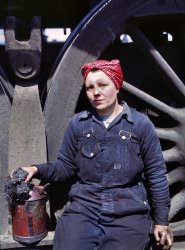
- Alray: 1943
- ... far east as Daggett, Calif." One of many images taken by Jack Delano documenting a Santa Fe freight train's journey from Chicago to ... Posted by Dave - 08/01/2012 - 1:42pm -
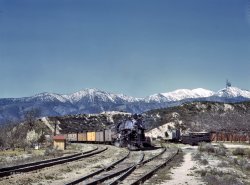
- Crackerbox: 1940
- ... Falls, Pennsylvania." Medium-format nitrate negative by Jack Delano. View full size.
Geeze... I'm now thoroughly depressed. Can ... Posted by Dave - 05/11/2009 - 11:00pm -
![Crackerbox: 1940 January 1940. "Family living in a 'crackerbox' slum tenement in Beaver Falls, Pennsylvania." Medium-format nitrate negative by Jack Delano. View full size.
Geeze...I'm now thoroughly depressed. Can we please get back to those nice scantily clad swimsuit models now?
Why be depressed?Hey - at least this was the exception, in the US.
"By 1965, 38% of houses in Glasgow had no fixed toilet or shower.
"By 1985, 5% of households still did not have a bath or shower." - Glasgow People's Palace (museum)
TightAnd I thought those camping trailers were small.
ReflectionsThe people reflected in the mirror don't seem like they are very close to being down and out, although looks can be deceiving. At least they seem to have retained their dignity.
And what the heck is a "crackerbox slum tenement" anyway?
I lived not far from Beaver Falls, at the little river town of Beaver on the north bank of the Ohio, back in the summer of 1956. It was one of the nicest little towns I've ever lived in, although you had to go across the Beaver River on the bridge to Rochester to buy a beer or see a movie.
Pillow TalkI remember those embroidered pillowcases. I bet Dad usually woke up with the word "Dad" imprinted on his forehead.
A poignant pictureDespite the family's desperate situation there are clues of a happy life framed in this shot. They are safe and warm from the snow storm seen through the window. Their child's dolls are nearby. On the dresser is a treasured portrait of a smiling young couple who are obviously in love. Despite the conditions they find themselves, the mirror reveals them smiling as they look over toward their child in the crib. This is a loving family that will survive their circumstances.
[Revised clue: The kid's on the bed, not in the crib. - Dave]
Door to where?I'm curious about the door behind the bed. It's latched and nailed shut.
The BabyI didn't realize that was a baby until I looked at the photo full sized. The guardian angel on the crib made me choke up.
The DoorThis might have been a room for rent.
Luz artificial.Por la traza de las sombras se aprecia que la luz procede de un punto interior de la habitación. Probablemente de un foco eléctrico o un flash, quizás de magnesio. La luz natural disponible en el interior, seguramente, habría reflejado una imagen más sombría y aún más deprimente.
The DresserThe finial over the mirror is missing. I bought a similar dresser at a yard sale years ago. The top part kept falling off.
The lamp on the dresserThese people owned a very nice "collectible of the future" -- an early 20th century Heintz Art Metal lamp, made by Otto Heintz of Buffalo, of dark bronze with sterling onlays. These are very sought after by collectors of Craftsman style furnishings, and nowadays usually sell for several hundred dollars, unless some eager beaver has polished the bronze. Below is a similar lamp.
Famous BeaveriteJoe Willie Namath was born there in 1943!
Jim and Della - revisitedSomething of this photo reminds me of O. Henry's "The Gift of the Magi". Here we have Jim and Della, some years later, though bereft of their treasures, still the hopeful parents of innocent babes, and still rich in the love they share for each other...
"And here I have lamely related to you the uneventful chronicle of two foolish children in a flat who most unwisely sacrificed for each other the greatest treasures of their house. But in a last word to the wise of these days let it be said that of all who give gifts these two were the wisest. Of all who give and receive gifts, such as they are wisest. Everywhere they are wisest. They are the magi."
Ansel Adams had the Zone System... I'm working on the points system. First I points it here, and then I points it there...
Wake up!That is one limp-looking baby. At first I thought it was a big doll.
NeighborsThe door likely led to another apartment. A lot of houses were subdivided later into apartments and rather than removing the old doorway, the landlord simply nailed it shut. I used to live in single family home converted into a duplex and a good many once-useful doors to the other half of the house were latched/nailed/boarded shut.
My Aching BackYou know that sleeping on that mattress had to be utter torture.
Home Sweet HomeHome is where the Heart is.
Buckle alignmentIt appears that the man, reflected in the mirror, has his belt buckle aligned on his side rather than in front above the zipper. What gives.
[It means he was a former hipster. - Dave]
Belt BuckleMy Gramps wore his that way until he died a few years back. My grandmother says it was cool in the 30's. He couldn't let that fad go; maybe he was waiting for it to come back in style.
Belt buckle bass playersI am a professional classical musician and have noticed that string bass players shift their belt buckles to the side, in order to avoid scratching the finish on the wood in proximity to their bodies.
They may or may not be doing that to be "hip". But it works.
MomI guess she's the one taking the shot. I love her little handbag behind the dresser lamp. And the "Dad" pillowcase.
Pennies from heavenThis photo is so sweet. I love the little details like the scissors hanging from the dresser, the photo of the happy couple and the purse on the dresser. The detail on the lamp is pretty wonderful too. The baby seems pretty blissful to me. Oh and the "Dad" embroidered on the pillowcase.
(The Gallery, Jack Delano)](https://www.shorpy.com/files/images/8c04426u.thumbnail.jpg)
- Mystic Manor: 1940
- ... Also a late-afternoon moon. Medium format negative by Jack Delano. View full size.
Creeeeepy Am I the only one who thinks ... Posted by Dave - 01/15/2019 - 12:07am -
![Mystic Manor: 1940 November 1940. "House, late afternoon. Mystic, Connecticut." Also a late-afternoon moon. Medium format negative by Jack Delano. View full size.
CreeeeepyAm I the only one who thinks houses with mansard roofs are creepy?
Undoubtedly Lurch will open the door and usher you in for your appointment with Sweeney Todd.
The Mansard FamilyMany people are not aware that Jack Delano took a few pictures of the interior of this house. Example below.
Your talents aren't wastedMystic Manor - I'm sure that a contractor somewhere will plagiarize this to name their next housing edition (or nursing home), Dave. If not, you have a new naming career ahead of you.
I Can't Find It -- Darn ItAs usual, I spent too much time trying to find this beauty, which strikes me as an unlikely teardown. But there are some hints I can leave for someone with better skills.
1. Delano took another picture of the house that is here:
http://www.loc.gov/pictures/item/2017792588/resource/
2. That picture (also taken in late afternoon) shows a partially commercial street that is near the town's river. It is also likely the house faces west or southwest, based on time of day, and the position of the shadows.
3. The address is 25 ????? If it's Willow Street (my best guess), Google Street View doesn't go there.
OMG!Is that Anthony Perkins' "Mother" in the second floor window?
When a 60 year old house looked "old"Unlike today when many houses 50-60 years old still have a modern or contemporary look, in 1940 a house from probably the 1880's really looked old compared to what was modern by that time so quickly were architectural styles changing. It also bears a vague similarity to what's called the Psycho House which is in reality a backlot stage set.
Found it! Broadway Avenue between Main and Washington.
Alas, this house didn't survive - it's a CVS parking lot. The key clue was the gas station across the street - once they go in, they RARELY come out. The porch on the house next door has been filled in, but the brackets at the eaves are unmistakable. The signpost in front of the tree is likely directing drivers down Route 1 toward Stonington, Westerly and ???. Naturally, the grand house is gone but that little bungalow across the railroad tracks (with the gable facing us) still stands.
I think I found the lot, but the house is goneFirst I found another photo from the area by Delano; had to magnify significantly to locate the house at the "end" of the road, behind a statue in the middle of an intersection. Then I found the statue on Google maps, and noted that 25 Broadway is the address of a CVS store, which is just behind the statue when viewed from the church.
http://www.loc.gov/pictures/resource/fsac.1a33860/
Shorpy members come through againMore fine sleuthing by the Shorpy brain trust in locating the site of the house.
Using the moon phase in the photo, I'll bet Neil deGrasse Tyson would be able to determine the day in November 1940 the photograph was taken.
Gone shortly after?According to Historic Aerials, the structure that was there in 1934 was gone by the next photographic record in 1957.
A shame, that was quite a house!
The Morgan HouseLooks like progress did this house in in the 1940s or '50s:
http://www.mystichistory.org/collectionsexhibit/vex1/6B184218-252A-4D19-...
A number of pictures (circa 1930) of the house in winter at this site.
http://www.mystichistory.org/collectionsexhibit/vex1/toc.htm
Neil deGrasse Tyson Not NeededBased on the moon phase the date is probably the 7th or 8th of November 1940. The house faces west and has late afternoon sunlight. The moon in the image is in the southeastern sky. I determined the approximate date from the moon phase shown on this website.
https://www.calendar-12.com/moon_calendar/1940/november
[Excellent sleuthing. Two frames away from this photo of the house (a sequence that can be found here) is an image of "crowd listening to election returns" for the 1940 presidential election, which was held on November 5. If the numbers written on the negatives are in chronological order, the election night photo was taken before the house photo. -Dave]
Another HOF-worthy threadThe thoughtful posts on this photo are hall of fame-worthy.
It's hard to overstate the sense of collaboration and community fostered by Shorpy's moderators and readers. Everyone's unselfish sharing of knowledge, sleuthing hints, and resources is a fine thing.
Edward Hopper was addicted to theseHe painted dozens of houses like this one.
(The Gallery, Jack Delano)](https://www.shorpy.com/files/images/SHORPY-8c03790a.thumbnail.jpg)
- Sex Was My Racket: 1943
- ... and SEX WAS MY RACKET. Medium-format safety negative by Jack Delano for the Office of War Information. View full size.
And, of ... Posted by Dave - 07/20/2021 - 1:03pm -
![Sex Was My Racket: 1943 March 1943. "Barstow, California. A brakeman on the Atchison, Topeka and Santa Fe Railroad resting in his caboose at night." Pinup reading material includes: STREAMLINE YOUR HIPS! and SEX WAS MY RACKET. Medium-format safety negative by Jack Delano for the Office of War Information. View full size.
And, of course ...He's sleeping in bed.
[A major cause of slumber. - Dave]
Ouch! Shoulda written he's SMOKING in bed.
Room With A ViewLooks like more than one caboose in the photo.
Who's making all that "racket"?Betty Grable?
Politically CorrectOur company once bought an insurance policy that protected us from race, sex, color, creed, disability, nationality, age or any other discrimination suits that could have rendered us liable. Our broker came to the store to inspect the premises. The first thing that went were the Girlie Calendars and risqué pinups in the warehouse area.
Necessity is the Mother of InventionIt looks like this guy could have benefited from a few carefully-chosen pages from the Sears catalog.
Extra PaddingSmart man. Looks like he borrowed the mattress from the upper berth, and brought a third one for good measure. Now if he can just keep that arm extended until the cig goes out...
I see the light!I have that lantern that's above his bed, my grandfather was a CNR (Canadian National Rail) railman and it was passed down to me over the years. It's built like a tank and is just as solid as it looks.
Head On CollisionThese days, this photo would cause a collision of the ATSF (BNSF) and the EEOC.
The door dingusis a spring latch to hold the door open - handy on moving rail cars. These are usually at the bottom corner and clamp to a small plate on the floor with a half-round projection. I suppose there was a higher shelf to mount the plate on. Normally, they come loose with a pull. Maybe this one stuck because mounting it in the middle of the door didn't give as much leverage, and so the string.
Details, detailsThe gadget on the lower part of the door is a spring loaded hook to hold the door open when the crew wants some air. The attached string is to easily/ quickly unhook to shut the door. Since our man is dressed, I would say the cigarette is to time the nap. The lantern above is to wake up if the Engineer pulls an emergency stop.
What's it for?So who's going to explain to me the purpose of the cord running from the door handle to the attachment on the door?
Barstow, CaliforniaStill every bit as exciting in 2012.
Notice: Brakeman SmithBe sure to sport your brand new bib overalls. Today is picture day on the ATSF.
Hot fingers!@ Histry2. He's probably not smoking in bed. That's just a way to get a ~15 minute nap. One tends to wake up when the hot ash gets near the fingers! It's a tried and true tradition.
Railroader's kidMy dad was a railroader (machinist) and my best friend's dad was a brakeman. Now and then we got to visit the caboose. I remember lots of posters in there that our mothers probably didn't want us to see... but I also remember the main bunks being in the cupola. What a great way to sleep, with that rhythmic clicking of the rails.
Between my freshman and sophomore years of college, I commuted by rail (then the Northern Pacific, later the Burlington Northern) on a railroad pass. I went west in the early morning and came home in the late afternoon. I usually fell asleep (again, that rhythmic clicking), and the conductors would always wake me up at my home town stop. We were all family then.
Emergency Equipment!Look at the casing above the door. This appears to be a signal flag - undoubtedly a red one - held in place by a couple of angled nails. In case of a breakdown, the conductor would walk down the tracks, well behind the train and stop any oncoming traffic. At night, he'd use a red lantern.
I presume that the flag is there for not only easy access but also because a flag is so much easier to misplace than a big old lantern.
(The Gallery, Jack Delano, Railroads)](https://www.shorpy.com/files/images/SHORPY_8d27502a.thumbnail.jpg)
- The 'Super Market': 1940
- ... the name for them in quote marks. 35mm nitrate negative by Jack Delano for the Farm Security Administration. View full size.
Shopping ... Posted by Dave - 05/02/2022 - 11:01am -
![The 'Super Market': 1940 May 1940. "The 'super market' in Durham, North Carolina." Back when self-service groceries were enough of a novelty that photographers put the name for them in quote marks. 35mm nitrate negative by Jack Delano for the Farm Security Administration. View full size.
Shopping for nostalgiaAleHouseMug - A coffee roaster in Burbank has bought the rights to Bokar Coffee and has attempted to recreate the taste.
JennyPennifer There are multiple recipes for Spanish Bar Cake, if you bake. Or you can order one directly from the Jane Parker Bakery. They supplied the cakes to A&P originally, and claim to be using the original recipe now. The only downside is that they cost much more than what you paid at A&P.
Y'all are on your own for those home killed fryers.
That's the Post Office in the background. The current location of the old A&P is now a parking deck.
I sometimes park hereAs J. W. Wright pointed out, the A&P at the corner of Rigsbee & E Chapel Hill is now a parking deck. The Post Office across the street is unchanged, and seems to be in good shape.
There were about a dozen A&P stores in Durham in 1940, but most were the old-fashioned small stores, not the new-fangled super markets.
Long gone nowA&P Supermarkets dominated Durham all the way into the 70's. Here is a little history of this one on Rigsbee:
https://www.opendurham.org/buildings/rigsbee-avenue-super-market
Tasty TimesBecause who doesn't remember fondly when advertising Fryers as being "Home Killed" wasn't seen as a major selling point?
Your meter is runningEven the cabbie couldn't pass up the home killed chickens! Love the brush lettering. Reminds me of my old Speedball text book. We used to go shopping with dad at the A&P when we lived in Cockeysville, MD in the early 60's. I can still smell the coffee when you passed the grinder! They had an A&P in Mathews, VA when my folks moved there in the mid-70's.
Three BlendsHow I miss Bokar Coffee.
Back when ...... you could park your bicycle on a sidewalk without a lock.
I love this photoAnd it looks for all the world like the building and market that was used in the movie "Driving Miss Daisy." I remember when most "supermarkets" looked like this - I was born in 1945 and I remember as early as 1948 going with my mother to the local Kroger store that was in a building smaller than this one. Great photo. More, more.
I remember it wellThe A&P will forever be to me one item: Spanish Bar Cake. Every now and then Mama would buy one -- dark, spicy, applesaucy cake studded with raisins and nuts and coated with a generous layer of cream cheese icing featuring a fork-tine design that resembled corduroy. We couldn't wait for a thick hunk of that cake to land in our hands. To smell it was almost as good as to taste it.
Much obliged... to archfan for the info. I am aware of the many recipes for "original" Spanish Bar Cake and have a few stored in my recipe file. A friend made one for me some years ago and the result was, shall we say, close but no cigar. Since we know that certain childhood memories are far more likely to be emotional than factual, it's possible that nothing not bought at the A&P, rung up with one of those gloriously chunk-kachunky cash registers and coming from my mother's hand will do it for me. But I do plan to make the recipe that I think would most approximate what I remember, and if it truly does the job, I will report back. As for Jane Parker, all I can say is that she's got her nerve charging $36 for that. Nope!
A Night to Rememberby Walter Lord was on the paperback carousel at the A&P on 11th Street in Waco, Texas, in 1955 -- my first exposure to the Titanic tragedy. I mentioned it to my mother and she told me she was 10 when it sank. She added it to her tab before checking out, and I was hooked on Titanic from that point on.
8 O'ClockMy memory goes back to when I was about 3, and my parents would take my maternal grandmother (she didn't drive) to the A&P in tiny New Freedom, Pa. I would gravitate quickly to the 8 O'Clock grinder area just to smell the coffee being ground.
Here I am now, at 74, typing out this memory, and I'm sipping a mug of 8 O'Clock Original. Just think of me as "hooked for life."
Not so fast, Broadway!Gimme a minute to write down that phone number.
Coffee"How I miss Bokar Coffee"
There was also a stronger brew -- Rokah.
Check my math.
[Your math does not add up! - Dave]
Super A&P MarketThe big sign on the roof looks like steel-embossed and porcelain enameled panels. They last forever. An unmolested version is a very sought after commodity today.
Broadway Taxi Broadway Taxi changed its name to Broadway Yellow Cab in the 1970s, and was still operating in the mid 1980s -- its depot was on Hunt Street.
(The Gallery, Jack Delano, Stores & Markets)](https://www.shorpy.com/files/images/SHORPY-8a33841a.thumbnail.jpg)
- Night Train: 1943
- ... Kansas. View full size. 4x5 Kodachrome transparency by Jack Delano, Office of War Information.
Wow, gorgeous. That's one for the ... Posted by Dave - 08/06/2012 - 10:57pm -
![Night Train: 1943 March 1943. The Santa Fe Yards at Argentine, Kansas. View full size. 4x5 Kodachrome transparency by Jack Delano, Office of War Information.
Wow, gorgeous.That's one for the desktop background. Talk about atmospherics.
Love it!Perfect exposure. I wonder how many takes it took him to get it right.
[This one took some Shadows & Highlights tweaking in Photoshop. - Dave]
A theory about the lightingThe exposure was fifteen minutes or so, but the railhouse lights were turned on for only a small portion of that. I can't figure out any other way you would see both the lantern-trail on the right and distinct figures in the house.
If so, I wonder if this was arranged with the yard workers. Did Jack Delano tell them to leave the lights off until he called down to them?
[Close up, we can see the figures in the railhouse (below) are a blur -- with a light trail from someone's cigarette. I don't think anyone was turning lights off or on. We know that some of Delano's nighttime exposures were around five to seven minutes. - Dave]
Very long exposureLook at the meandering light streak on the right, clearly a lantern or flashlight being swung in the hand of somebody walking through the frame. The shutter had to be open for several minutes at least for him to walk so far.
The more I look at this picture, the more I love it.
[Plus, a cigarette! See above. - Dave]
Night Train: 1943This looks like a painting. Look at the rail house the figures in it look painted not real
Railhouse Is...In case you are wondering just what the "railhouse" is, its a scale track that weighs freight cars when they are diverted on the track that runs just in front of the windows.
Time travel.You realize these old Kodachromes are time travel machines, don't you?
Old B/W photos are like looking into a history book. Many washed out old color photos are the same.
These old Kodachromes take you back to the instant they were made. You're standing right there, peeking in on others and half expecting them to look right back.
Night Train 1943Re: Kodachrome. I took a night photo in Rome in 1958 with ASA 10 Kodachrome. The camera was on a tripod, exposure was on the button at 30 sec. @ f 2.8. If this 4x5 was shot, say, at f8, it would have been, as Dave says, 5 to 7 minutes, plenty of time to record the lanterns of the walkers and the cigarettes of the men in the railhouse. Shooting with slow films was a challenge, but not as daunting as you might think. You could hand-hold in daylight, 5.6 at 1/60th, or even 1/100th in bright sun. My 50+ year-old Kodachromes are as good as new, but not so with Ektachromes, which are all red now, and Anscochromes, which have just faded away.
Probably east of 42nd StreetBased on the recently-posted photo at https://www.shorpy.com/node/14960 , I think this is on the east side of 42nd Street (the bridge in the background), looking west. The blur of white in the top center of this photo is from the light tower seen at the upper right of 14960, and the trees at the upper left in this photo seem to match the ones on the east side of 42nd Street (by the big warehouse) in 14960.
Today, there is a small shack, and a larger BNSF building, in the general area. http://maps.google.com/maps?ll=39.081542,-94.675506&spn=0.002361,0.00324...
(The Gallery, Kodachromes, Jack Delano, Railroads, WW2)](https://www.shorpy.com/files/images/1a34713u1.thumbnail.jpg)
- The Handsome Family: 1941
- ... the Pine Camp relocation area." Medium-format negative by Jack Delano for the Resettlement Administration. View full size.
Geetars ... Posted by Dave - 09/13/2011 - 7:14pm -
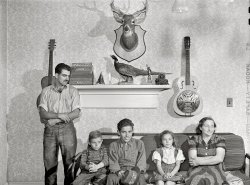
- Archie and Veronica: 1940
- ... Facebook page puts it: "I think that's Archie.") Photo by Jack Delano. View full size.
Towers It could also be for a similar reason ... Posted by Dave - 01/04/2013 - 12:48pm -
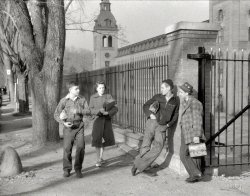
- Black Tie: 1943
- ... creosote for eight hours." 4x5 Kodachrome transparency by Jack Delano. View full size.
Stinkytown My wife grew up on Terre Haute, ... Posted by Dave - 08/30/2012 - 4:46pm -
![Black Tie: 1943 March 1943. Albuquerque, New Mexico. "At the Santa Fe R.R. tie plant. The ties made of pine and fir, are seasoned for eight months. The steaming black ties have just come from the retort, where they have been impregnated with creosote for eight hours." 4x5 Kodachrome transparency by Jack Delano. View full size.
StinkytownMy wife grew up on Terre Haute, Indiana, where they had a creosote factory that made railroad ties. Some days we could smell Terre Haute seven miles east on I-70 before we got there. I can only imagine how nasty it would be to work with the chemical.
If you believe Google MapsActo the address given in the various SuperFund papers this is in the vicinity of the current autorack terminal, but there s a lot of empty land there.
Concrete ties are used in high-speed service and in some nasty places where wood ties don't last long, but for the most part creosote-treated ties are what get set under almost all freight rail in the USA. So if you want to know what creosote smells like, the trackside is the place to go. Unless you like sniffing telephone poles.
My old jobI had a summer job unloading those creosote-infused railroad ties. That was a nasty, nasty job. The ties are very hot and creosote vapors burn, so you have to cover all exposed skin with calamine lotion. But it’s the middle of summer and it’s hot, so anywhere your sweat lands on you, it washes away the calamine, and you get a burn.
Not a happy summer.
Donkey EngineThe small shed in the center of the photo appears to house a steam "donkey", a steam-operated winch, used to pull the narrow-gauge tie cars in and out of the various sidings. The two men in the center seem to be wrangling the donkey cable, and the large round objects on the ground near them are probably large pulleys, used for changing the direction of travel of the cable.
Black Tie, forsoothI know I've said it before, but I'll say it again: the only thing better than these excellent photos is the delicious titles you come up with for them. This level of cleverness is a sort of high-wire act and I constantly marvel at your surefootedness way up there ...
Creosote steaming!I wouldn't like walking there in the clouds of creosote!
Anyway, this is an interesting photo. Thanks for sharing it here!
Railyard ParkIs this the area that's now Railyard Park? Definitely interesting to see what it looked like back in the day.
If toothpicks were dollarsthis would just about cover the national debt.
I lovethe smell of creosote in the morning!
Not surprisinglyThis became a Superfund site. It's just south of the GE aircraft engine plant.
Air QualityI'm trying to imagine how pungent those aromas would have been.
Like Cookies from the OvenMmmm the smell of creosote. I used to buy it at the hardware for dippin' the bottom of fence posts. Not for sale to the general public anymore. The environmentalists took that simple pleasure away from us. Rotten.
Save the trees!Now they make them out of concrete!
Smells like ... Progress!There are still a few historic rail lines where you can immerse yourself in that old-time railroad smell. The Colorado narrow gauge lines, like Durango & Silverton, Cumbres & Toltec Scenic, and the Georgetown Loop come to mind. Ahhh, the heady perfume of coal smoke, hot grease, and of course, creosote.
Train SmellAlways loved the smell of the old railways. Of course, the old telephone poles smelled the same on a hot summer day.
The only place to really immerse yourself in the scent is a railway museum. The Museum of Science and Technology here has a big room filled with cars and engines. When I worked there, it was my job to dust these babies. The job was a pleasure only because of the smell of trains.
Smells not unlike my car does, at the moment, because of a slipped brake pad.
Where's Godzilla?You'll need him when those caterpillars hatch!
Blue puddlesI work as a trackman for a Northeastern railroad. We still put in wooden ties all the time. Creosote is a real nasty little chemical that not only burns, but causes a slipping hazard as it will ooze out of the tie in high heat and will make the wood feel like a newly waxed floor. And if it rained the day before, look out for those nasty little blue puddles all over the place.
Note the narrow gaugeThe creosote trains, center and right foreground and middleground, are running on narrow gauge track, while the flat cars on the left and the gondolas and crane (right background) are on standard gauge track. Hard to tell, but the narrow gauge could be 3 feet, possibly less (30 inches?). It doesn't look like there is any dual-gauge trackage in the photo, but this was not uncommon in industrial settings such as steel mills.
The superb quality of the photograph (view full size!) is cause yet again to lament the demise of Kodachrome, the finest color transparency film ever produced, bar none. Although K-chrome in cut film sizes such as 4x5 had not been produced for many years, 35mm size was made right up to the end of production in 2009. It is missed by all serious film photographers. Kodachrome images, properly stored, will still be vivid and true a hundred years from now. I wouldn't bet a nickel on anything digital lasting one-tenth as long.
[Nonsense. - Dave]
(The Gallery, Kodachromes, Jack Delano, Railroads)](https://www.shorpy.com/files/images/1a34734u.thumbnail.jpg)
- Mike Evans: 1943
- ... & North Western R.R." 4x5 Kodachrome transparency by Jack Delano for the Office of War Information. View full size.
It's ... Posted by Dave - 08/30/2012 - 4:44pm -
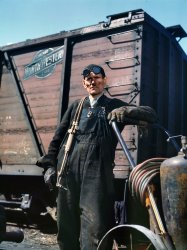
- Passing the Chief: 1943
- ... Barstow and San Bernardino." Medium-format negative by Jack Delano for the Office of War Information. View full size.
Mt Baldy? ... Posted by Dave - 12/31/2012 - 11:39am -
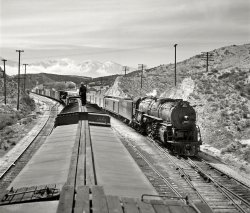
- Serve in Silence: 1942
- ... View full size. 4x5 Kodachrome transparency by Jack Delano. Click here for a closeup of the poster on the wall.
Serve in ... Posted by Dave - 07/30/2012 - 10:03pm -
![Serve in Silence: 1942 December 1942. A winter afternoon in the North Proviso yardmaster's office, Chicago & North Western Railroad. View full size. 4x5 Kodachrome transparency by Jack Delano. Click here for a closeup of the poster on the wall.
Serve in Silence!
SERVE IN SILENCE!
When you hear something pertaining to the war or ANY of its phases from someone supposedly "in the know", they should be severely reprimanded for divulging information regardless of its value, importance or authenticity. And don't repeat it!
"The Axis Rats" are ever on the alert, even though you are among friends you can be overheard.
The very next time some BIG MOUTH spouts about how things are going on all fronts, shut him up! If he can run this war let him offer his services to our GOVERNMENT.
They'll give him a GUN.
RoomWhy can't they bring Kodachrome back?...please?!?!
[Kodachrome is still around, at least in the 35mm size. - Dave]
Love the……coffee in the tin on top of the stove. Looks like it would be Chase & Sanborn brand.
Coffee can Used to put an empty can full of water on top of the stove in winter to provide moisture. Houses are sealed up pretty tight these days, moisture tends to stay inside. In the old days things would dry up pretty good indoors once it got cold out side. Hence the can on the stove.
Old timers used to rely on frost to seal up air leaks to the outside from the inside. Moist air would provide a faster seal. It would also provide a "warmer" heat.
It was the first thing that appeared on top of my wood burner when I first set it up. An old neighbour grabbed a Folgers tin and plopped it, half full of water, onto my hot stove. "To keep the house from drying up, and to make it warmer."
Yardmaster's shoesBy the looks on the yardmasters shoes (a great shine) he must not have gotten out in the yard a lot. Love the pix.
Coffee CanLook in the coffee can on the right...it looks like the yardmaster may be heating up a little toddy to warm where the stove can't.
Chase & SanbornChase & Sanborn have always been one company. In 1938 they began the "Chase & Sanborn Hour" initially with Mae West, and later with Edgar Bergen and Charlie McCarthy, and searching eBay (those people have everything!) reveals an 1898 ad for "Seal Brand Coffee" produced by the Chase & Sanborn Coffee Company.
The can on the stoveIt's SANBORN coffee. Chase joined Sanborn later. - SGL
BeautifulThis is a beautiful, evocative photograph; one of the few color pictures posted here that really speak to me.
Who Needs 3D?This photo draws me in. The feelings I get every time I look at it are visceral. You feel the heat radiating from the coal stove. You can smell The scent of stale cigar and pipe smoke and coal hang in the air. You can hear the hollow scrape of chairs across the floor and the quiet echo of the regulator clock punctuated by the rumble of a slow freight passing by...
Anyone else notice the clasped hands resting on a blue leg, just behind and to the left of the stove? Or the melted snow about the feet of the gent sitting on the padded bench by the wall.
A marvelous glimpse into the past.
(The Gallery, Kodachromes, Chicago, Jack Delano, Railroads, WW2)](https://www.shorpy.com/files/images/1a34620u.thumbnail.jpg)
- Downgrade: 1943
- ... is one long downgrade of more than 2,700 feet." Photo by Jack Delano, Office of War Information. View full size.
Road to Sin City ... Posted by Dave - 07/29/2009 - 9:30pm -
